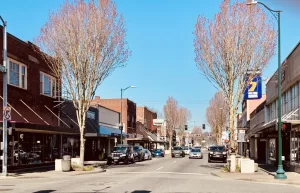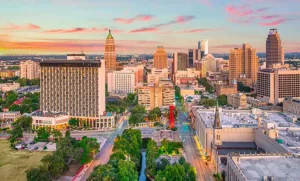Moving To Puyallup, WA: Things To Know
Go Back To Previous PageMoving to Puyallup, WA, offers a climate typical of the Pacific Northwest, marked by mild temperatures and significant rainfall. Puyallup’s location in the Puget Sound region influences its weather patterns, providing a moderate and welcoming climate for those who prefer cooler weather without extreme cold or heat. Throughout the year, Puyallup experiences an average high of about 77°F in the warmer months and a low of around 34°F during the colder months.
Precipitation is relatively common, with the city receiving an average annual rainfall of 41 inches, slightly higher than the national average.
The area also sees a modest snowfall, averaging about 4 inches annually. Puyallup enjoys a range of weather conditions seasonally. Summers are typically warm but not overly hot, with July being the warmest month, often reaching up to 77°F.
Milder temperatures and less precipitation than winter mark spring and fall transitional seasons. Winters in Puyallup are characterized by cooler temperatures and increased rainfall, with December often being the wettest month. This showcases the region’s lush, green landscape, which many residents cherish. Despite the frequent rain, Puyallup benefits from about 142 sunny days per year, which is less than the national average but adequate for enjoying outdoor activities in beautiful surroundings.
Housing and Real Estate in Puyallup, WA
The housing market in Puyallup, WA, is currently quite dynamic. Properties frequently change hands, and pricing is on an upward trend. As of early 2024, the median listing price for homes in Puyallup was reported to be around $613,900, reflecting a significant increase of approximately 9.6% compared to the previous year.
Puyallup was reported to be around $613,900, reflecting a significant increase of approximately 9.6% compared to the previous year.
This indicates a strong seller’s market where demand outpaces supply. Homes in this area have been selling relatively quickly, often at or above the asking price, highlighting the market’s competitiveness. Properties range widely in price depending on size, location, and amenities, with typical homes offering three to four bedrooms.
Puyallup’s real estate landscape offers potential buyers various options, from more compact townhomes to spacious single-family homes.
The average time on the market for homes before sale is relatively short, often around 27 to 28 days, suggesting that properties are moving quickly due to high demand.
These bustling market conditions see frequent bidding wars, with homes commonly receiving multiple offers. The median sale price per square foot has also risen, averaging about $288. This number further illustrates the area’s growing appeal to homebuyers.
Economy and Employment
The economy of Puyallup, WA, is vibrant and diverse and characterized by significant involvement from various sectors. Retail trade, healthcare, social assistance, and manufacturing are the most critical industries contributing to employment. Additionally, sectors like utilities, public administration, and company management are among the highest paying, providing a robust economic base for the city.
Puyallup’s strategic economic development policies foster a business-friendly environment that attracts investments and supports a mix of businesses, ranging from large corporations to small local enterprises. Employment opportunities in Puyallup have been growing, with a job market increase observed over the past year. Future job growth is predicted to be significantly higher than the national average, reflecting the city’s economic resilience and potential for expansion.
This economic stability is supported by major employers in the city, which includes well-known companies across various industries. The city’s commitment to improving infrastructure and community resources further enhances the employment landscape, making Puyallup an attractive place to live and work.
Education in Puyallup, WA
A robust public school system supports early childhood and continuing education opportunities in Puyallup, WA. The Puyallup School District is one of the largest in the state, offering a range of educational programs, including a Spanish dual language program for K-6 students.
The district actively integrates arts, culture, and technology into its curriculum, evidenced by national recognition for programs like high school journalism. Additionally, special education services provide comprehensive support, ensuring all students receive an education in the least restrictive environment.
For younger children and adult learners, the community has access to programs like the Early Childhood Education and Assistance Program (ECEAP), which provides state-funded preschool aimed at school readiness. Pierce College offers a variety of continuing education courses that cater to career development and personal enrichment. This reflects the community’s commitment to supporting educational development at all stages of life.
Healthcare Facilities
Puyallup, WA, is well-equipped with healthcare facilities that cater to various medical needs, from emergency services to long-term care.
The MultiCare Good Samaritan Hospital is a prominent facility in the area. It provides a wide range of services, including emergency care, and specific metrics show its responsiveness and quality of care compared to state and national averages.
This hospital has a comprehensive emergency department that has been recognized for its timely care, particularly for patients with stroke symptoms who require prompt brain scans. In addition to hospital care, Puyallup offers specialized facilities like the Life Care Center of Puyallup, which provides inpatient and outpatient rehabilitation and long-term skilled nursing care.
This center features extensive services, including a Parkinson’s support group and amenities to enhance patients’ comfort and recovery. The center’s location also offers access to local attractions, which families can enjoy while their loved ones receive care.
Crime Rates and Safety
Puyallup, WA, has a higher crime rate than many other communities of similar size in Washington and nationwide. The overall crime rate in Puyallup is notably high, with residents facing a 1 in 13 chance of becoming victims of either violent or property crime.
The property crime rate, in particular, is significant, with occurrences such as burglary, larceny, motor vehicle theft, and arson being the most prevalent. The rate of violent crimes, including assault, robbery, and rape, is also higher than in most American communities, indicating a need for caution and awareness for residents and visitors alike.
Despite these statistics, some parts of Puyallup are considered safer than others, and crime rates vary across neighborhoods. The southeast part of Puyallup is generally considered safer than the central areas with higher crime rates.
This spatial variation in safety underscores the importance of local knowledge and community engagement in crime prevention and safety measures. Local law enforcement and community programs are crucial in addressing these challenges and improving Puyallup’s overall safety and quality of life.
Movers in Puyallup, WA, have stated that this is one of the main reasons why people choose to relocate there.
Cost of Living in Puyallup, WA
Puyallup, WA, presents a varied cost of living landscape that is somewhat higher than the national average. The overall cost of living in Puyallup is estimated to be about 33% higher than the U.S. average, with housing being a significant factor in this equation. Puyallup’s median home price is around $645,000, and the average rent for a two-bedroom home is approximately $2,152, 46% more than the national average rent.
These figures highlight the city’s relatively expensive housing market compared to other areas nationwide. Beyond housing, everyday expenses such as groceries, healthcare, utilities, and transportation contribute to the overall cost of living.
For instance, Puyallup’s utility costs are lower than the national average, which can offset other expenses. The recommended annual income to live comfortably in Puyallup varies depending on household size. Estimates suggest around $95,760 for a family and $55,200 for a single person.
This income level helps to manage the higher costs associated with living in this region of Washington State.


